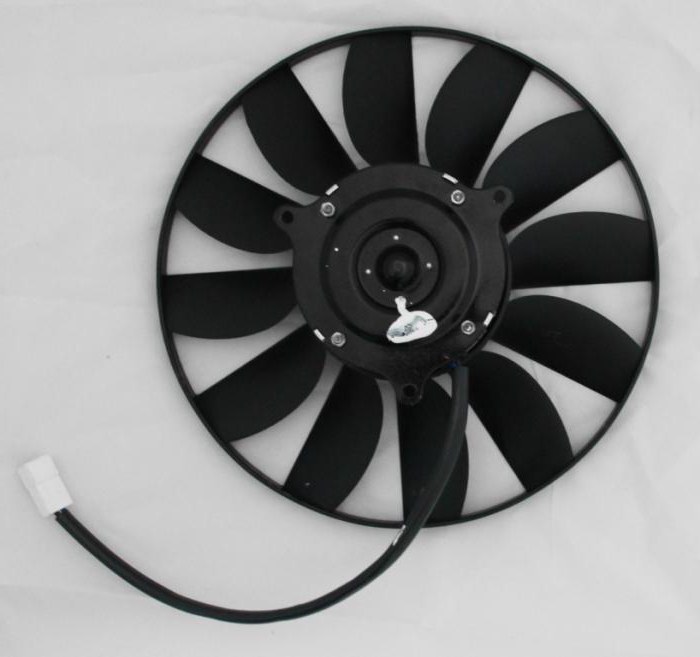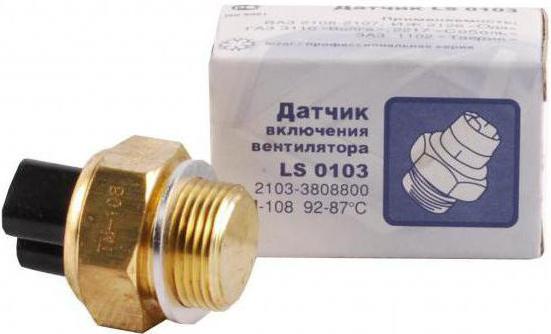Most owners of VAZ-2107 cars faced the problem of engine overheating due to the untimely inclusion of the radiator fan. Such a malfunction poses a serious threat not only to the cooling system, but to the entire power unit. Raising the coolant temperature to critical levels can damage the cylinder head gaskets, the valve cover, and cause jamming of the moving parts of the motor.
Most often, the radiator fan does not work due to problems with the sensor of its inclusion. This can be either a banal lack of contact on the connectors, or the failure of the device as a whole. In this article, we will talk about what measures can be taken if the fan on sensor on the VAZ-2107 has lost its functionality, and we will also consider the process of checking and replacing it.
Signs of engine overheating and precautions
If you, while driving a car, find that the arrow on the device indicating the temperature of the coolant has switched to the red sector and continues to deviate towards its increase, it would be better to stop on the side of the road and immediately turn off the engine. If this is not done, antifreeze or antifreeze will simply boil and try to break out, violating the tightness of the system. Continuing to move in such a situation is quite dangerous. Having stopped, it is necessary to check the operability of all elements of the cooling system and establish the cause of overheating. Further, if possible, it should be eliminated. And if this is not possible, tow the car to the nearest service station.
What is wrong with the fan?
If you suspect a malfunctioning radiator fan in overheating, first check it for proper operation. It’s not difficult to do this. Disconnect the electrical connector from the motor, and connect electricity to the battery terminals. Do not reverse polarity!
If the fan does not work with direct connection, the cause must be sought in the drive. If the electric motor is working, the problem most likely lies in the elements that ensure its inclusion. It can be a fuse, relay, wiring and sensor.
Further verification
Further verification should be carried out according to the “from simple to complex” scheme. It is almost impossible to diagnose wiring without the appropriate tools and skills. The situation is similar with relays. Check it yourself is unlikely to succeed, especially in the field. The only thing that can be done is to pull out a similar device from an adjacent socket or another car and insert it into the corresponding connector. Earned - the reason is established, the fan does not work - go ahead.
There is no problem checking the fuse. We find the desired insert in the mounting block, check it with an ordinary tester or a home-made probe made of two wires and a lamp, and the result is obvious. If necessary, change the fuse and continue driving. But if this time we made a mistake, the problem must be sought in the sensor for turning on the fan.
Features of the cooling system in various versions
Before proceeding with the diagnosis of the sensor, it must be found. The fact is that in carburetor "sevens" and in cars with controlled fuel injection it is in different places. Moreover, in VAZ-2107 injection machines there is no sensor for turning on the fan as such. Its functions are performed by DTOZH (coolant temperature sensor). Let us consider in more detail the location of these devices in carburetor and injection "sevens".
Where is the fan switch on?
For all outdated “classic” versions, the sensor is located on the body of the cooling radiator. To be precise, the bottom right. Outside, it looks like a brass nut on the “30” with two pins pulled out. Lift the hood, look at the back of the radiator - you will definitely see it. The principle of operation of the sensor is very simple. The thermocouple responds to an increase in temperature, closes the contact, and voltage is applied to the fan. In cars with controlled fuel injection, the fan is turned on by the command of the electronic unit based on data received from the sensor. In other words, the computer itself controls all the processes. But where is the fan on sensor for the injection “sevens”?

As already mentioned, they do not have such a device at all. Do not look for it on a radiator or anywhere else! But pay attention to the thermostat. A coolant temperature sensor is installed on its body. He then transfers to the electronic control unit all the necessary information about the temperature of the coolant.
Sensor check
Now let's talk about how to check the fan on sensor (VAZ-2107). And let's start with the carburetor engine. Everything is very simple here. All you have to do is disconnect the wires from the sensor. To do this, remove the electrical connector from its terminals. To determine if the device is working properly, turn on the ignition and short-circuit the contacts on the connector. If the whole thing is in the sensor, the fan will surely turn on.
It may happen that the fan switch does not respond correctly to temperature. In other words, the contact closure mechanism works, but with a larger value. So, for VAZ-2107 carburetor machines, the fan enable sensor must close the circuit when the coolant reaches a temperature of 92 degrees, and open it at 87 º.

For engines with controlled fuel injection, the verification process is slightly different. Since the VAZ-2107 injection cars do not have a fan enable sensor, you need to check the temperature controller. But first, you should inspect the presence of voltage on the connector pins. Take the tester and turn it on in voltmeter mode. Close the negative wire of the device to the “mass”, and connect the positive wire to pin “A” on the connector. Turn on the ignition. The tester should show a voltage of at least 12V. If its value is reduced, the problem must be sought in the control unit. But if everything is OK with the voltage, unscrew the temperature controller from the nozzle for further testing.
Checking the sensor consists in measuring its electrical resistance at different temperatures. Put the tester in ohmmeter mode and measure the resistance at its contacts. It is noteworthy that it grows and falls in inverse proportion to the temperature of the coolant (20 º - 3.5 kOhm; 40 º - 1.5 kOhm; 80 º - 340 Ohm; 90 º - 250 Ohm). In the process of measuring resistance, the controller can be heated by putting it in a container of hot water. The temperature of the fan enable sensor (VAZ-2107, injector) for different versions of ECU firmware can be 92-95 º. Its resistance is close to zero.
It should be noted that the sensors for turning on the fan and the temperature of the coolant cannot be repaired. Therefore, when the slightest malfunction is identified, they must be replaced. Consider the replacement process for each of the engines separately.
The process of replacing a sensor on a carburetor engine
Here, the process may seem more complicated. After all, given that the sensor is located below, you will have to drain the coolant. And for this you need to look for a viewing hole, remove the engine protection, etc. But you can not do this. Simply quickly wrap a new sensor in place of the old one. Naturally, a little coolant will pour out, but its amount will be limited to 20-30 ml. In addition, you can always substitute a correctly cut plastic bottle under the joint.
So, prepare a new sensor and a “30” wrench. Disconnect the wires from the device. Carefully unscrew the sensor with a key. Continue to unscrew it by hand, pressing it against the radiator body. When the sensor comes off the thread, you can pinch the hole with your finger, and with your other hand begin to screw in a new element. At the same time, do not lose the o-ring that is worn on the threaded part of the device. That, in fact, is the whole process. It remains to connect the wires to it, start the power unit and check whether everything works.
Replacing the sensor for turning on the fan: VAZ-2107 (injector)
In an injection engine, a coolant drain is not needed to replace the sensor. It is located high enough, so its leakage will be minimal. To replace, you will need a new temperature sensor and a key to "19". First, disconnect the connector, then unscrew the old controller and screw the known-good one into its place. We turn on the power and start the engine. If everything is done correctly, the operation of the fan is guaranteed.
Some useful tips
Before turning off the power of the sensors, especially on the "sevens" with injection engines, it is recommended to remove the negative terminal from the battery. When choosing sensors to turn on the fan or coolant temperature, it is better to give preference to branded factory products. After replacing, be sure to check the tightness of the threaded connection. If necessary, use heat-resistant automotive sealant.